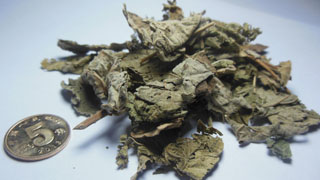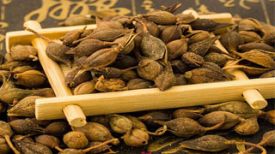
1. Alias
Frost resistant leaves, hibiscus flower leaves, autumn hibiscus leaves.
2. Plant morphology
Deciduous shrubs or small trees. The bark is gray white, and the stem has star shaped hairs and short hairs. Leaves alternate, wide oval shaped heart-shaped, flowers grow on a single branch at the end of the leaf axil, bracteoles 8, linear; Calyx bell shaped, 5-lobed, lobes ovate triangular, bracts and sepals densely covered with yellow brown hairs; Petals 5 or double, wide inverted oval, initially white or light red, later dark red, flower diameter 8 cm; Monomeric stamen; There is one pistil, five chambered ovary, and five lobed stigma. The capsule is flattened and spherical, with a diameter of about 2.5 centimeters, and is covered with yellow bristles and soft hairs. The fruit has 5 petals. The seeds are mostly kidney shaped. The flowering period is from August to October, and the fruiting period is from September to November.
3. Origin distribution
Distributed in Henan, Guangxi, Sichuan and other places.
4. Harvesting and processing
Pick intact green leaves in summer and autumn, tie them into small bundles, and dry them in the sun.
5. Characteristics of medicinal herbs
There are petioles, about 0.3 cm thick, and the leaves are often curled and broken. When intact, they are flattened and form an oval shaped heart shape, which is yellow brown. The leaves are large and often folded, with a gray green leaf surface and a light green back. The veins are raised and covered with gray star shaped hairs. Crispy and fragile, with a slight odor and a slightly pungent taste.
6. Sexual Taste Returning to the Classics
Cold in nature, slightly spicy and bitter in taste. Return to the lung meridian and liver meridian.
7. Effect and Function
Clearing heat and detoxifying, cooling blood and stopping bleeding, reducing swelling and relieving pain. A heat clearing and blood cooling medicine classified under the category of Qingre medicine.
8. Clinical application
Take 10-30 grams and decoct; Apply an appropriate amount topically and apply to the affected area after grinding. Used for treating lung heat cough, vomiting blood and leakage, abscess and ulcer toxins, lymphadenitis, appendicitis, etc., externally applied for treating abscess and joint abscess, burns and scalds, etc.
9. Pharmacological research
Pharmacological experiments have shown that leaf and flower extracts have significant antibacterial effects.
10. Chemical composition
Containing flavonoid glycosides, phenols, amino acids, tannins, reducing sugars, etc. There are still reports that it contains components such as quercetin, rutin, quercitrin, isoquercitrin, emodin, and kaempferol-3-O - β - rutinoside.
11. Usage taboos
Pregnant women are prohibited from taking it.
12. Compatibility prescription
① Treatment of carbuncle, swelling and toxin: Take hibiscus leaves (ground) before Double Ninth Festival and Cang'er (burned, ground) before Dragon Boat Festival, divide equally. Mix honey water around and its poison will not dissipate. (Iron Well Column of "Ancient and Modern Medical System")
② Healing Snake Pills (Herpes Zoster): Grind fresh hibiscus leaves in the shade and apply rice paste to the affected area. (Fujian Chinese Herbal Medicine)
③ Treating swelling and pain in the cheeks and jaw, or breaking into sores: hibiscus leaves are not limited in quantity. Mash and apply it, tie it with silk, and change it every day. (Furong Fu Fang from "Qi Xiao Liang Fang")
④ Treat venomous snake bites: appropriate amount of fresh leaves and flowers of hibiscus. Wash thoroughly, add a little salt, and massage the swollen area around the wound. Change twice a day. (Zhejiang Medicinal Plant Chronicles)
⑤ Treatment for sprains and bruises: Take an appropriate amount of fresh leaves and flowers of hibiscus, crush and apply externally; Or dry and grind powder, mix with wine, vinegar or tea juice for application. (Journal of Medicinal Plants Along the Yangtze River)
⑥ Treatment for red eye swelling and pain: hibiscus leaf powder, water, apply to temples. (Fei Hong Ji "Cooling Cream)
⑦ Treatment of lung abscess: Take 15g of hibiscus leaves (or 60g of roots), boil in water, and add honey in moderation. (Anhui Chinese Herbal Medicine)
⊙ The content of the article is for clinical reference only. Non TCM professionals are not allowed to test drugs.


